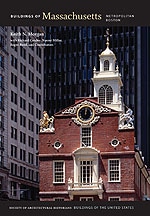
Holden Chapel (1742) represents yet another imitation of Oxford and Cambridge, whose colleges had chapels of their own. Attributed to Boston artist John Smibert, Holden originally faced the Common but received a new entrance that reoriented it to Harvard Yard in the nineteenth century. Similarly, Hollis Hall, erected in 1762 by master builder Thomas Dawes, faced the street and the Cambridge Common, contributing to the college row. This dormitory followed the two-entrance organization of Massachusetts Hall (HY2). Massed under a hipped roof and dominated by a pedimented center pavilion, its facade was organized around a false center door. Adjacent, Charles Bulfinch designed Stoughton Hall in 1804–1805 to mimic Hollis, although he enriched it subtly by the use of granite for the window lintels and entranceways.

